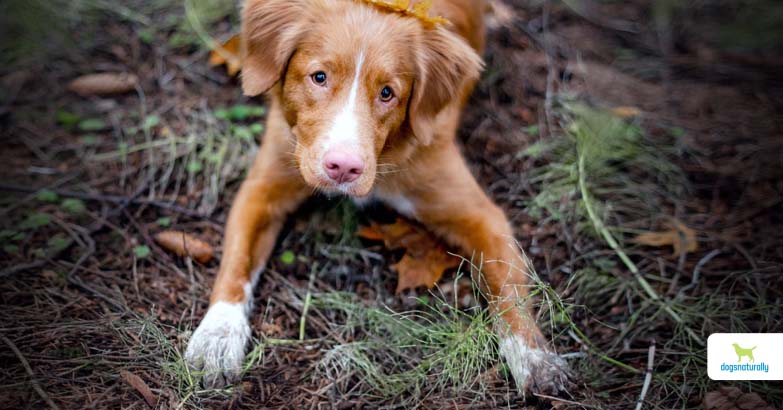The idea of our dogs having worms is enough to make our skin crawl (pun intended). So how do dogs get worms? Most commonly, dogs pick up intestinal worms in areas where other worm-infected dogs have pooped or from eating an infected prey animal. But more on that in a bit, let’s start by reviewing the types of worms that can infect your dog.
Types of Worms
Here are the types of intestinal parasites, aka worms, your dog can get. Dogs of all ages can get worms, but they are most susceptible to worms when they are puppies.
- Roundworms
- Tapeworms
- Hookworms
- Whipworms
- Heartworms*
*Note: Dogs can only get heartworms through the bite of an infected mosquito, so we they’re not included in this article.
RELATED: Natural heartworm prevention without pills …
Symptoms of Worms in Dogs
It can be difficult to know if your dog has worms just by looking at him. But there are a few visible signs …
- Adult worms in your dog’s stool
- White rice-looking pieces in your dog’s stool or near their rear end (these are usually tapeworm segments)
- Poor coat condition
- Scratching and biting the base of the tail
- Bum scooting
- Weight loss
- Pot-belly
- Vomiting
- Diarrhea (this can contain blood)
- Anemia (pale/white gums)
It is important to know that worms can be in your dog’s system without any symptoms. So, fecal tests are the best way to know if your dog has worms.
RELATED: White specks in dog poop …
How Common Is It For Dogs to Get Worms?
Hookworms, whipworms and roundworms are the most common gastrointestinal parasites in US dogs (1).
A large-scale, 7-year survey with data from over 39 million fecal examinations in the US found that there has been a subtle but significant increase in the percentage of dogs getting hookworms and roundworms.
Worm prevalence (in dogs receiving veterinary care) is approximately:
- Roundworms 1.8–5.0%
- Hookworms 2.5–4.5%
- Whipworms 0.8–1.2%
These numbers are very different from the often quoted “stat” that 36% of dogs have worms. This stat is likely based on a survey done in 1996. This survey found that 36% of all the dogs studied had at least one type of worm.
The big problem? This survey only looked at 6,458 fecal specimens, and they came only from dogs in animal shelters. This would have wildly skewed the results and shown a much higher prevalence of worms (2).
Tapeworms are less common because dogs cannot get infected by ingesting tapeworm eggs directly. The eggs must first pass through an intermediate host before they can become infectious.
How Do Dogs Get Worms?
Your dog can pick up worms anywhere an infested dog (or other animal) has shed worm eggs or larvae. If your dog likes to hunt and eat wild prey, he could also be at increased risk for worms.
Eating Stool Or Soil That Contains Worm Eggs
Dogs can get roundworms, hookworms or whipworms by eating soil, grass or feces contaminated with worm eggs. Avoid areas where there’s a lot of dog or other animal waste.
Commonly contaminated locations include:
- Walking paths
- Dog parks
- Doggy daycares
Some hookworm larvae species can burrow into your pet’s skin through the pads of their feet. They can also burrow into your skin if you walk over them with bare feet.
RELATED: Why do dogs eat poop? (And how to fix it) …
Eating Worm-Infested Prey Animals
Don’t let your pet hunt wild prey animals like mice, rabbits and birds. These are all intermediate hosts for tapeworms and can pass the worms to your pup.
Note: For raw feeders, freezing the meat for 10 days will kill tapeworms.
Fleas Or Lice
Fleas and lice are also intermediate hosts for tapeworms. Your dog will often lick or bite at the area with fleas or lice, and in the process he’ll swallow the tapeworm-infected insect.
Keep your dog, home and yard free of fleas and promptly deal with any flea infestations.
Rabbit Poop
Rabbit poop usually doesn’t harm dogs, but sometimes it can contain roundworms or tapeworms. Keep your yard clear of rabbit poop if possible and keep your pup away from it on walks.
From Their Mother
Roundworms and hookworms can pass from an infested mother to the pup through her milk while nursing. Unborn puppies can also get worms from the placenta.
Skin Contact
Hookworms can burrow through your dog’s skin, so dogs can get hookworms from contact with poop that has hookworm larvae in it.
How Long Can Worm Eggs Survive In The Environment
Roundworms, hookworms, and whipworms are all transmitted by your dog eating worm eggs. The eggs pass through the feces of an infected animal into the soil or grass, where they can live for a surprisingly long time.
Length of survival time in the environment:
- Roundworms and tapeworms: Several months
- Hookworms: Months to years
- Whipworms: Up to 5 years
Are Worms Contagious From Dog To Dog?
Worms don’t pass directly from dog to dog. Instead, the worm eggs or larvae pass from an infested dog to the environment, which can then infect another dog. Common sense and good precautions can greatly help reduce your dog’s risk of getting worms.
Tips To Keep Your Yard Parasite-Free
If your dog gets worms, want to make sure you follow these steps to keep your home and yard worm-free. You cannot see if you have parasites living in your yard because the eggs are microscopic. However, there are some things you can do to help prevent contamination in your yard.
1. Pick up all waste promptly.
A clean yard is your first defense from parasites. Roundworms are not infectious in fresh feces, but if allowed to sit, they can become infectious and move into the soil
2. Sprinkle diatomaceous earth around.
Diatomaceous earth (DE) is the fossilized remains of aquatic organisms. Its sharp, microscopic edges damage the exoskeleton of insects and cause them to dry out and die. DE is effective for killing fleas (which can carry tapeworms).
3. Use a natural yard control spray (or make your own).
There are some great natural sprays that can help kill off and control the spread of worms. These will typically contain one or more essential oils like cedarwood, lemongrass, or catnip.
At some point in your journey as a pet owner, you’ll likely have to deal with worms of one type or another. Because worms can have a severe impact on your pet’s health, you will want to have a plan for deworming.
RELATED: Find the best natural dewormer for dogs ….
References:
- Drake, J., Carey, T. Seasonality and changing prevalence of common canine gastrointestinal nematodes in the USA. Parasites Vectors 12, 430 (2019)
- A Prevalence of Canine Parasites Bases on Fecal Flotation, which appeared in The Compendium on Continuing Education for the Practicing Veterinarian, Vol. 18, No. 5, May, 1996.











